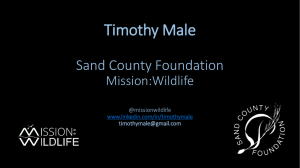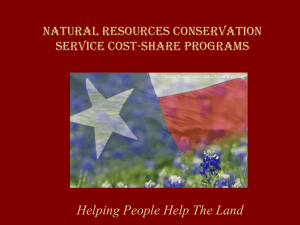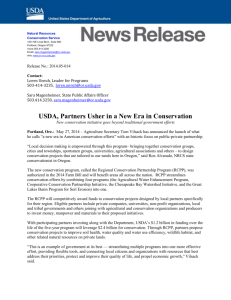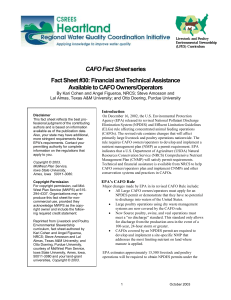Small Scale / Small Field Conservation
advertisement
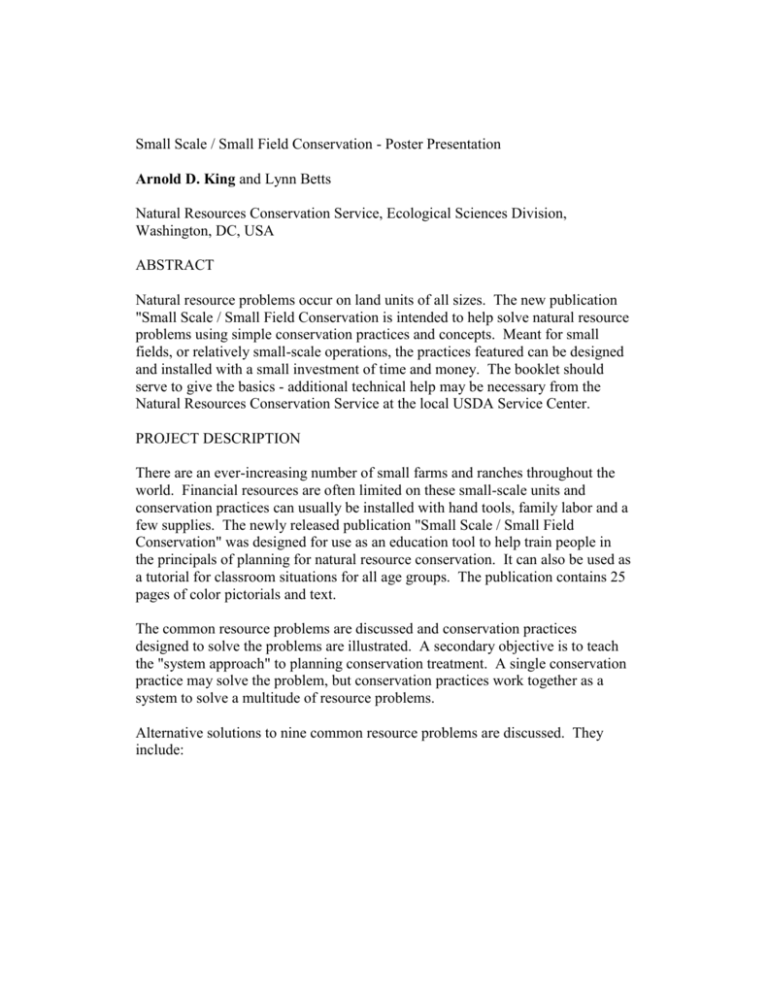
Small Scale / Small Field Conservation - Poster Presentation Arnold D. King and Lynn Betts Natural Resources Conservation Service, Ecological Sciences Division, Washington, DC, USA ABSTRACT Natural resource problems occur on land units of all sizes. The new publication "Small Scale / Small Field Conservation is intended to help solve natural resource problems using simple conservation practices and concepts. Meant for small fields, or relatively small-scale operations, the practices featured can be designed and installed with a small investment of time and money. The booklet should serve to give the basics - additional technical help may be necessary from the Natural Resources Conservation Service at the local USDA Service Center. PROJECT DESCRIPTION There are an ever-increasing number of small farms and ranches throughout the world. Financial resources are often limited on these small-scale units and conservation practices can usually be installed with hand tools, family labor and a few supplies. The newly released publication "Small Scale / Small Field Conservation" was designed for use as an education tool to help train people in the principals of planning for natural resource conservation. It can also be used as a tutorial for classroom situations for all age groups. The publication contains 25 pages of color pictorials and text. The common resource problems are discussed and conservation practices designed to solve the problems are illustrated. A secondary objective is to teach the "system approach" to planning conservation treatment. A single conservation practice may solve the problem, but conservation practices work together as a system to solve a multitude of resource problems. Alternative solutions to nine common resource problems are discussed. They include: Slowing sheet and rill erosion 1. Residue Management 2. Contouring 3. Stripcropping 4. Contour Buffer Strips 5. Grass/Tree Planting 6. Cover Crops Stopping Gullies 1. Water Chutes 2. Drop Structures 3. Pipe Structures 4. Grassed Waterways Reducing Impacts of Wind 1. Crop Residue 2. Cover Crops 3. Windbreaks/Shelterbelts 4. Vegetative Wind Barriers Managing grazing land 1. Grazing Systems 2. Water Supply 3. Fencing Managing Plant Nutrients and Pests 1. Nutrient Management Basics 2. Pest Management Basics Improving Soil Quality 1. Manage Organic Matter 2. Maintain Chemical Balances 3. Conserve Topsoil Wetland, Woodland, and Wildlife Issues 1. Managing Wetlands 2. Managing Woodlands 3. Managing Wildlife Stabilizing Streambanks 1. Exclusion Fencing 2. Water Crossing 3. Rock Riprap 4. Grass Filter Strip 5. Bioengineering Farmstead Issues 1. Manure Stacking 2. Composting 3. Water Gutters 4. Heavy Use Protection 5. Diversions The final portion of the publication discusses "making a plan". The objective is to bring the information together and formulate a record of decisions, or what is referred to as a conservation plan. CONCLUSIONS This project resulted in a high quality teaching tool for use in the field or classroom. The original objective was to provide a guidance document for public distribution at the NRCS field office level. However, it can be used as a tutorial with an instructor available in a classroom setting. It can also be helpful to an urban homeowner who wants to know the basic principals of natural resource conservation. ACKNOWLEDGMENTS USDA Natural Resources Conservation Service funded the project. The development team consisted of the following NRCS employees: Arnold King - Ecological Sciences Division, NHQ Lynn Betts - Communications Officer, Iowa State Office Bill Hughey - Engineering Division, NHQ Larry Holmes - National Small Farms Coordinator, NHQ Fred Gasper - State Engineer, Michigan State Office Lisa Krall - Soil Scientist, New England States Stefanie Aschmann - Agroecologist, Watershed Institute, Nebraska Charlie Rewa - Biologist, Wildlife Institute, Little Rock Arkansas Corresponding Author Contact Information: Poster Presentation Arnold King, NRCS, Ecological Sciences Division, Washington D.C., Office location is Box 6567, Ft. Worth, Texas 76115, Phone 817-509-3213, Fax 817-509-3210, aking@ftw.nrcs.usda.gov.






